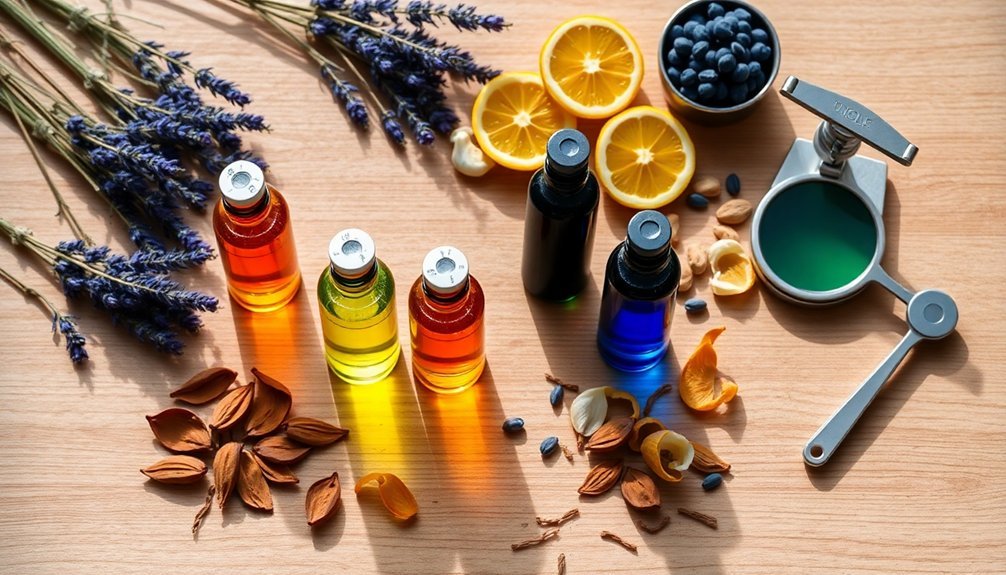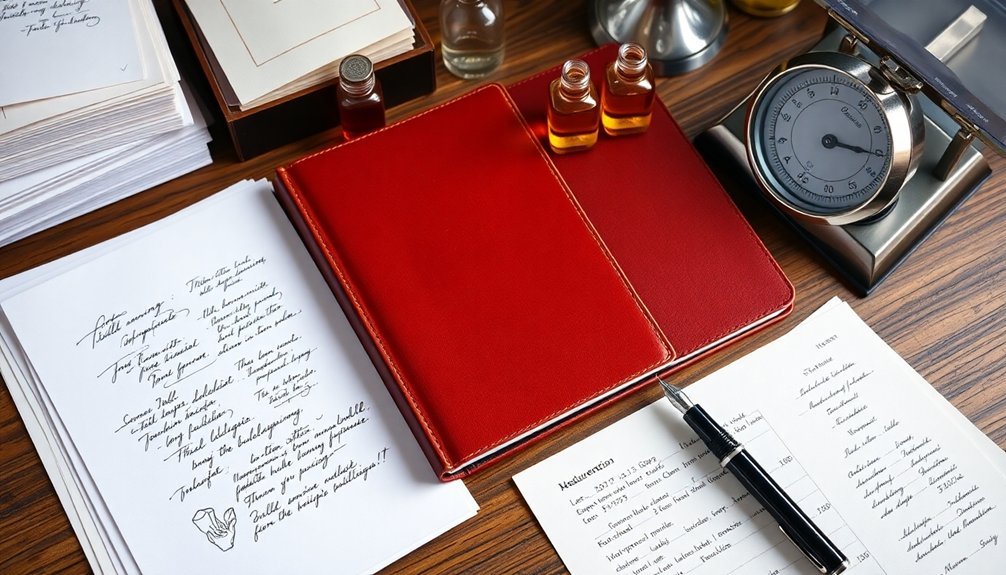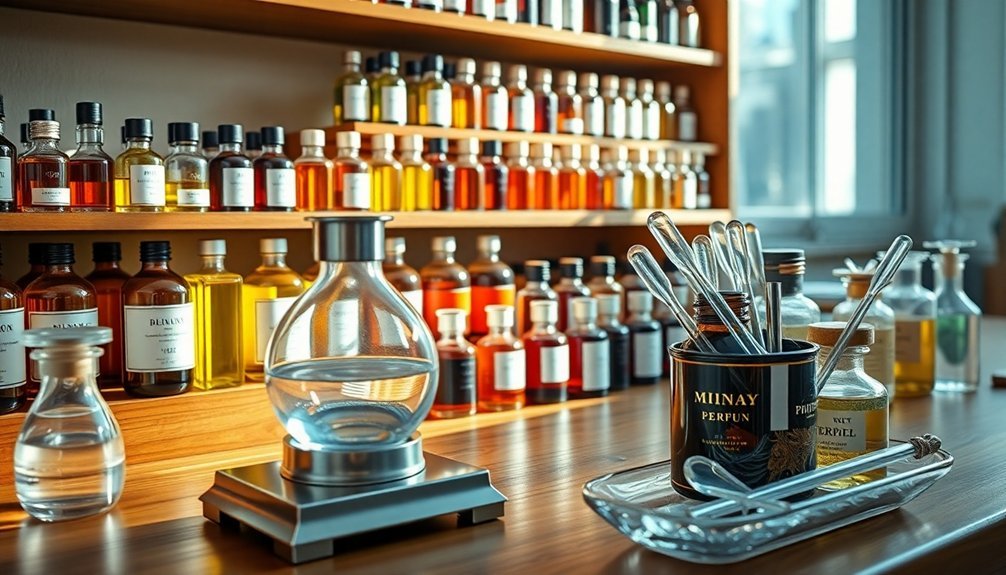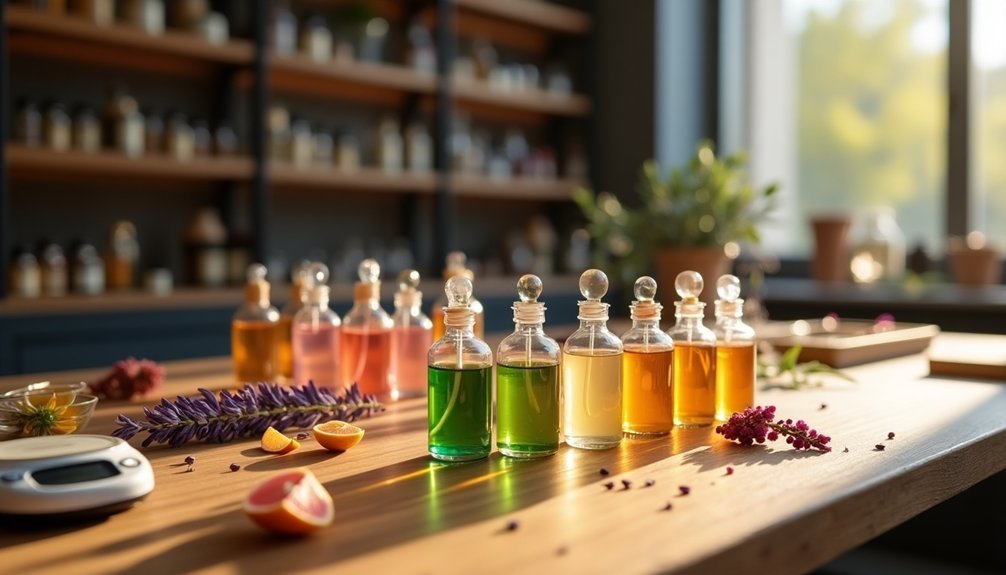You'll need essential supplies to create quality perfumes safely and consistently. Start with precise measuring tools like digital scales and glass beakers, protective gear including nitrile gloves and safety goggles, and proper storage containers to preserve your ingredients. Raw materials like essential oils and binding agents form your foundation, while filtration equipment guarantees professional results. Documentation tools help track your formulas and progress. Let's explore the must-have equipment for your perfume-making journey.
Essential Measuring Tools for Precise Perfume Creation

When creating perfumes, accurate measurements can make the difference between a masterpiece and a mishap.
You'll need a digital scale that measures to the hundredths (0.00) and can handle up to 200-500 grams for consistent, precise formulations.
Glass measuring cylinders and beakers are essential for handling liquids and oils. Make sure to clean them with soapy water and sterilize with ethanol before use. Quality scales typically cost between $100-150 for professional accuracy.
For smaller quantities, you'll want both glass and disposable pipettes – glass versions with rubber bulbs are more sustainable for long-term use.
Don't forget graduated cylinders and flasks for mixing ingredients.
You'll also need glass funnels with filter papers to remove unwanted particles from your concentrates.
Safety Equipment to Protect Yourself While Blending
Safety equipment is your first line of defense while blending perfumes. You'll need proper PPE to protect yourself from chemical exposure and potential hazards when working with concentrated fragrances and essential oils. Maintaining proper material compatibility between your equipment and perfume ingredients is crucial to prevent unwanted chemical reactions.
| Essential Safety Item | Purpose |
|---|---|
| Nitrile Gloves | Protects hands from chemical contact |
| Safety Goggles | Guards eyes against splashes |
| Lab Coat & Apron | Shields clothing and skin |
Before you start blending, make certain you've got a well-ventilated workspace and quick access to emergency equipment like eye wash stations and fire extinguishers. Don't forget to inspect your equipment regularly – check for damaged wiring, loose guards, or worn components. If you're working with flammable materials, you'll need anti-static tools and proper grounding to prevent static discharge. Remember, safety isn't optional – it's an essential part of your perfume-making journey.
Basic Storage Solutions for Your Fragrance Collection

Your fragrance collection needs proper glass bottles with clear, waterproof labels to maintain ingredient identification and prevent confusion during blending.
You'll want to invest in temperature-controlled storage units, like beauty mini-fridges or insulated cabinets, to protect your fragrances from heat and light damage. Keep bottles stored upright to prevent any potential leaks or degradation over time.
Start by organizing your storage space with dedicated sections for raw materials, finished blends, and testing samples, making sure everything is easily accessible yet protected from environmental factors.
Glass Bottles And Labels
The elegant simplicity of glass bottles serves as the foundation for proper perfume storage. You'll appreciate how glass's non-porous nature prevents unwanted chemical reactions while preserving your fragrances' integrity.
Its UV-protective qualities and aesthetic appeal make it the ideal choice for your perfume-making endeavors.
When storing your glass bottles, you'll need to keep them in single layers with adequate spacing to prevent breakage.
Don't forget to wrap them properly using bubble wrap or foam, especially around the bottle's mouth and lid.
For effective inventory management, you'll want to implement a clear labeling system that includes essential information like contents, dates, and handling instructions.
Your labels should be moisture-resistant and securely attached, making it easy to track your collection while maintaining professional standards.
Temperature-Controlled Storage Units
Proper temperature control stands at the heart of preserving your fragrance collection.
You'll need to maintain temperatures between 55°F and 80°F to protect your perfumes from degradation. A dedicated perfume refrigerator or wine cooler can provide the consistent cool environment your fragrances need.
When choosing a storage unit, opt for one that shields your perfumes from UV light and minimizes air exposure.
You'll find that opaque or tinted glass display cases work well for this purpose. If you're storing larger quantities, consider investing in a climate-controlled storage unit equipped with proper safety features like fire alarms and water supply systems.
Don't forget that original packaging boxes can serve as additional protection.
For the best results, keep your storage area dust-free and monitor humidity levels when possible.
Organizing Your Storage Space
Organizing fragrance collections requires four essential storage considerations: location, containment, categorization, and accessibility.
Start by choosing a cool, dark space away from direct sunlight and temperature fluctuations. Your bedroom closet or wardrobe shelves are ideal spots, offering better conditions than humid bathrooms.
Next, invest in storage boxes or cabinets with doors to protect your fragrances from light damage.
You'll want to categorize your collection by fragrance family, usage, or brand – whichever system works best for your needs. Keep a detailed inventory list to track your supplies.
For easy access, organize perfumes by frequency of use and consider using clear dividers or acrylic risers to separate categories.
Don't hesitate to get creative with DIY solutions like repurposed spice racks or custom-built compartments to maximize your storage space.
Must-Have Raw Materials to Start Your Journey

Building a perfume-making starter kit requires careful selection of essential raw materials that'll form the foundation of your creations. Start with versatile floral oils like lavender and jasmine, then add citrus notes using orange and bergamot.
You'll need woody elements like sandalwood and cedar to create depth, while aromatic herbs such as thyme and basil will add fresh, green dimensions.
For fixatives that'll help your fragrances last longer, invest in synthetic compounds like Iso E Super and linalool.
While traditional animal-derived ingredients are often restricted, you can achieve similar effects using modern synthetic alternatives for musk and ambergris notes.
Don't forget essential binding materials like benzoin and labdanum, which will help blend your compositions seamlessly while adding richness to your perfume base.
Filtration Equipment for Professional-Grade Results
When creating professional-grade perfumes, you'll need reliable filtration equipment to achieve crystal-clear results and remove unwanted particles.
Start with a stainless steel filter housing equipped with hydrophilic PES membrane pleated filters to remove precipitated impurities. For larger batches, consider a plate and frame filter press that can handle various volumes while maintaining sanitary conditions.
You'll also need specific filter media. Choose cellulose depth filters for reducing particulate loading and haze, or activated carbon-impregnated media if you need color correction.
For volatile liquids, invest in a Zeta-Pak lenticular cartridge filter system.
Don't forget to maintain your equipment regularly. Clean and sterilize with ethanol between uses, and verify your systems are compatible with the solvents you'll be working with.
Quick media changeouts will help keep your production flowing smoothly.
Documentation Tools for Recipe Development

Professional perfume development demands meticulous record-keeping to track your formulations and experiments.
You'll need a thorough documentation system to manage your raw materials library, formula modifications, and regulatory compliance.
- Raw materials database to track suppliers, costs, IFRA limits, and dilution calculations for each ingredient
- Formula management tools to record weights, scaling factors, and modifications while developing your scents
- Regulatory documentation sheets to guarantee your creations meet industry standards and safety guidelines
Your documentation tools should help you organize ingredients by the fragrance pyramid, track different accord combinations, and maintain detailed testing notes.
Whether you're creating simple blends or complex fragrances, proper documentation guarantees you can replicate successful formulas and learn from each iteration of your perfume development process.
Mixing and Blending Equipment Essentials
Beyond meticulous documentation, successful perfume creation requires a well-equipped workspace with specialized mixing and blending tools.
You'll need a variety of vessels, including glass and ceramic bowls for blending, dark glass containers for storage, and stainless steel bowls for general use. For precise measurements, invest in digital scales that measure down to 0.01g, along with graduated cylinders and beakers.
Essential mixing tools include offset spatulas, glass stirring rods, and metal spatulas for handling different ingredient consistencies.
Don't forget a magnetic stirrer with magnet bars for efficient blending. For filtration, you'll want stainless steel strainers, lab-quality filter paper, and separatory funnels to separate oils from hydrosols.
Complete your setup with pipettes and droppers for precise ingredient addition and a conductivity meter to monitor solution properties.
Organization Systems for Your Perfume Workshop

Your perfume workshop needs a thorough organization system that combines digital inventory tracking with physical storage solutions to maintain control of your supplies.
You'll want to invest in label makers, clear containers, and dedicated storage areas to keep your ingredients, tools, and finished products properly sorted and easily accessible.
The layout of your workspace should follow a logical flow, with separate zones for mixing, storing, and testing your creations, while integrating digital management tools to track your formulas and inventory levels.
Digital Inventory Management Tools
Modern perfume making demands efficient tracking systems to manage your growing inventory of raw materials, finished products, and supplies. Digital inventory management tools provide real-time visibility into your stock levels and help prevent costly mistakes.
You'll find cloud-based systems particularly valuable for:
- Tracking batch numbers and expiry dates of essential oils and fragrances
- Setting up automatic alerts when supplies run low
- Generating detailed sales reports to identify your best-selling scents
Today's RFID technology and barcode scanners integrate seamlessly with your accounting software, making it easy to monitor your entire supply chain.
These tools guarantee you'll never run out of critical ingredients or overstock expensive materials. Plus, with advanced analytics, you can forecast seasonal demands and optimize your inventory levels for maximum profitability.
Labels and Storage Solutions
While creating beautiful fragrances is an art, organizing your perfume-making supplies is a science that requires careful attention to detail.
You'll need a robust labeling system with durable, easy-to-read labels that stick well to both glass and plastic surfaces. Consider color-coding your labels to quickly identify different perfume categories or creation dates.
For storage, invest in clear plastic boxes for samples and glass bottles for finished fragrances. Keep your workspace efficient with shelves and trays that maximize vertical space.
You'll want to track everything in spreadsheets, including ingredients, dates, and quantities. Don't forget to designate specific areas for backup supplies and decanting materials.
Store your perfumes in cool, dark places using containers that protect their quality, and keep travel-sized options handy for testing and demonstrations.
Workspace Layout Design
Designing an efficient workspace layout forms the foundation of successful perfume making. You'll want to organize your workshop using a system that matches your workflow, whether it's by fragrance type, season, or brand. A well-planned layout guarantees safety while maximizing productivity.
For ideal organization, consider these essential layout elements:
- Safety zone with proper ventilation, protective gear, and emergency equipment
- Dedicated mixing area with clean surfaces and easy access to tools like scales, beakers, and pipettes
- Organized storage sections using clear labeling and logical groupings
Your workspace should allow for flexibility as your collection grows. Keep frequently used items within arm's reach and maintain visual clarity by using dividers or separate sections.
Remember to document your fragrance notes and maintain consistent categorization to streamline your creative process.
Frequently Asked Questions
How Long Do Perfume-Making Supplies Typically Last Before Needing Replacement?
You'll find most fragrance oils last about a year, but with proper storage in cool, dark places, they can last longer. You should replace them if you notice any changes in scent or rancid smells.
Can I Use Kitchen Equipment Instead of Laboratory-Grade Tools?
You shouldn't use kitchen equipment for perfumery as it lacks the required precision, sterility, and material compatibility. You'll need proper laboratory-grade tools to guarantee accurate measurements and avoid contamination in your fragrance creations.
What's the Minimum Budget Needed to Acquire Basic Perfume-Making Supplies?
You'll need around £200-300 for basic supplies, including a precise scale (£50), essential oils starter kit (£100), glass bottles (£30), and basic tools like droppers and funnels (£20-120) to begin making perfumes.
Where's the Best Place to Source Authentic Perfumery Materials?
You'll find authentic perfumery materials from reputable suppliers like Aftelier, Eden Botanicals, and Hermitage Oils. They offer verified essential oils, absolutes, and aromachemicals with quality guarantees and proper documentation.
Should I Buy Supplies Gradually or Invest in Everything at Once?
You'll benefit most from buying supplies gradually. It's easier on your budget, helps you learn each material thoroughly, and prevents waste. Plus, you won't feel overwhelmed while developing your perfumery skills.
In Summary
You're now equipped with the fundamental supplies needed to begin your perfume-making journey. Start with these essential tools, safety gear, and storage solutions before exploring complex fragrance creation. Remember to maintain detailed documentation of your formulas and keep your workspace organized. As you develop your craft, you'll discover which additional tools enhance your perfume-making process and help create your signature scents.





Leave a Reply